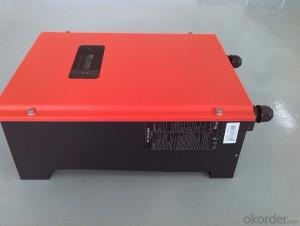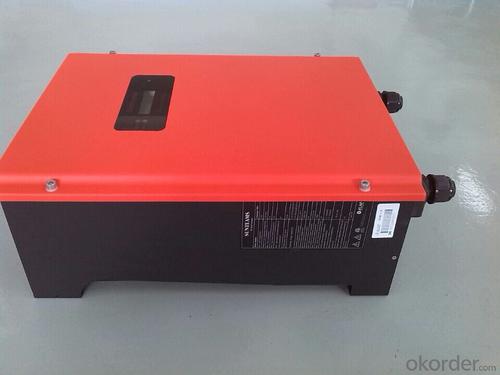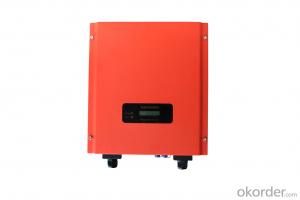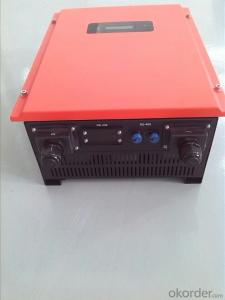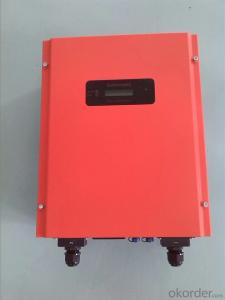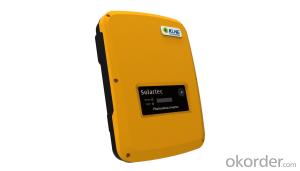ON-GRID INVERTER Sunteams 1500/2000/2500/3000
- Loading Port:
- China Main Port
- Payment Terms:
- TT OR LC
- Min Order Qty:
- -
- Supply Capability:
- -
OKorder Service Pledge
Quality Product, Order Online Tracking, Timely Delivery
OKorder Financial Service
Credit Rating, Credit Services, Credit Purchasing
You Might Also Like
The Sunteams 1500 ~5000 series is applicable to various rooftops and small scale photovoltaic grid-connected power plants. Their nominal output powers are 1.5 kW, 2 kW, 2.5 kW,
3 kW, 3.6 kW, 4 kW and 5kW respectively.
This series is transformerless and has a wide range of MPPT input voltage. Its maximum conversion efficiency and MPPT tracking accuracy reach 97.6 % and 99.5 % respectively. The maximum DC voltage reaches 550 V. Its multilingual LCD display facilitates easy operation. It has waterproof direct plug-in terminals. It has overvoltage, islanding, short-circuit, overloading and overheating protection functions. Its IP65 protection degree will ensure it runs well in various tough environments.
Efficient
■ The maximum efficiency of the inverter can reach 96.5 % - 97.6 %
■ Transformerless design
Flexible
■ For indoor and outdoor installation
■ Maintenance free
Simple
■ ‘Plug and play’connection for easy installation
■ Designed for hanging with simple and easy installation
Communicative
■ RS232 / RS485 interfaces as standard
■ Optional Bluetooth technology
- Q: How does a solar inverter handle variations in battery charge levels?
- A solar inverter manages variations in battery charge levels by monitoring the voltage and state of charge of the batteries. It adjusts the flow of electricity from the solar panels to the batteries accordingly, ensuring that the batteries are charged optimally without overcharging or undercharging. This helps maintain a stable and efficient energy storage system.
- Q: Can a solar inverter be used in conjunction with a smart home system?
- Yes, a solar inverter can be used in conjunction with a smart home system. The smart home system can integrate with the solar inverter to monitor and control the energy production, consumption, and storage. This allows for better optimization of energy usage, remote monitoring, and automated control of various devices and appliances within the smart home.
- Q: How does a solar inverter protect against overvoltage and overcurrent?
- A solar inverter protects against overvoltage by continuously monitoring the voltage level of the solar panels. If the voltage exceeds a safe threshold, the inverter automatically limits the power output or shuts down temporarily to prevent damage to the system. Similarly, to protect against overcurrent, the inverter monitors the current flowing through the system. If the current exceeds a safe limit, the inverter adjusts the output power or shuts down to avoid overheating and potential electrical hazards.
- Q: How does a solar inverter handle shading on the solar panels?
- A solar inverter typically handles shading on solar panels by using a technology called Maximum Power Point Tracking (MPPT). MPPT enables the inverter to constantly monitor the performance of each individual solar panel and adjust its voltage and current to ensure maximum power output. When shading occurs on a panel, the MPPT algorithm detects the drop in power and adjusts the system to bypass the shaded panel or operate it at a different voltage, allowing the other unshaded panels to continue producing power efficiently. This helps to mitigate the impact of shading on the overall system performance.
- Q: What is the role of a solar inverter in voltage and frequency regulation during grid disturbances?
- The role of a solar inverter in voltage and frequency regulation during grid disturbances is crucial to maintaining the stability and reliability of the electrical grid. During grid disturbances, such as voltage fluctuations or frequency deviations, the solar inverter acts as a control device that helps regulate and stabilize the electrical parameters. In terms of voltage regulation, the solar inverter continuously monitors the voltage level of the grid and adjusts its output accordingly. If there is an increase in grid voltage, the inverter will reduce its output to prevent overvoltage conditions. Conversely, if there is a decrease in grid voltage, the inverter will increase its output to compensate and maintain a stable voltage level. This regulation ensures that the voltage supplied by the solar inverter aligns with the grid's voltage requirements, preventing damage to electrical equipment and ensuring the safe operation of the grid. Similarly, the solar inverter also plays a role in frequency regulation during grid disturbances. The inverter constantly monitors the frequency of the grid and adjusts its output frequency to match the grid's frequency. If the grid frequency deviates from the standard frequency, the inverter will modify its output frequency to bring it back to the desired level. This frequency regulation is essential for maintaining the synchronization of various electrical devices connected to the grid, preventing equipment damage, and ensuring the stability of the grid. Overall, the solar inverter's role in voltage and frequency regulation during grid disturbances is to provide stability and reliability to the electrical grid. It acts as a control device that continuously monitors and adjusts its output to maintain the desired voltage and frequency levels, thus preventing potential damage to electrical equipment and ensuring the smooth operation of the grid.
- Q: What is the maximum DC input current for a solar inverter?
- The maximum DC input current for a solar inverter can vary depending on the specific model and manufacturer. It typically ranges from a few amps to several hundred amps, depending on the size and capacity of the inverter.
- Q: Can a solar inverter be used in systems with different module strings?
- Yes, a solar inverter can be used in systems with different module strings. Solar inverters are designed to be compatible with a wide range of module string configurations, allowing for flexibility in system design and installation. The inverter's maximum input voltage and power ratings should be considered to ensure compatibility with the different module strings, but as long as these specifications are within the inverter's limits, it can effectively convert the DC power generated by the module strings into AC power for use in the system.
- Q: What is the maximum number of solar panels that can be connected to a single inverter?
- The maximum number of solar panels that can be connected to a single inverter depends on the specifications and capacity of the inverter. However, there is no fixed number as it varies depending on factors such as the size and wattage of the panels, the voltage and capacity of the inverter, and the overall system design. It is recommended to consult the manufacturer's guidelines or a professional installer to determine the maximum number of panels that can be connected to a specific inverter.
- Q: How do you calculate the maximum power point voltage for a solar inverter?
- To calculate the maximum power point voltage for a solar inverter, you need to consider the voltage at which the solar panel generates the highest power output. This can be determined by using the voltage-current (V-I) curve of the solar panel and finding the point where the product of voltage and current is maximum. By analyzing this curve, the maximum power point voltage can be identified, which is crucial for optimizing the performance of a solar inverter.
- Q: Are solar inverters compatible with smart home systems?
- Yes, solar inverters are compatible with smart home systems. Many modern solar inverters come with built-in communication capabilities, such as Wi-Fi or Ethernet connectivity, which allow them to integrate seamlessly with smart home systems. This enables homeowners to monitor and control their solar energy production, consumption, and storage through their smart home devices or applications.
Send your message to us
ON-GRID INVERTER Sunteams 1500/2000/2500/3000
- Loading Port:
- China Main Port
- Payment Terms:
- TT OR LC
- Min Order Qty:
- -
- Supply Capability:
- -
OKorder Service Pledge
Quality Product, Order Online Tracking, Timely Delivery
OKorder Financial Service
Credit Rating, Credit Services, Credit Purchasing
Similar products
Hot products
Hot Searches
Related keywords
